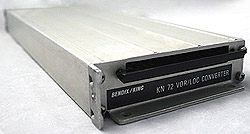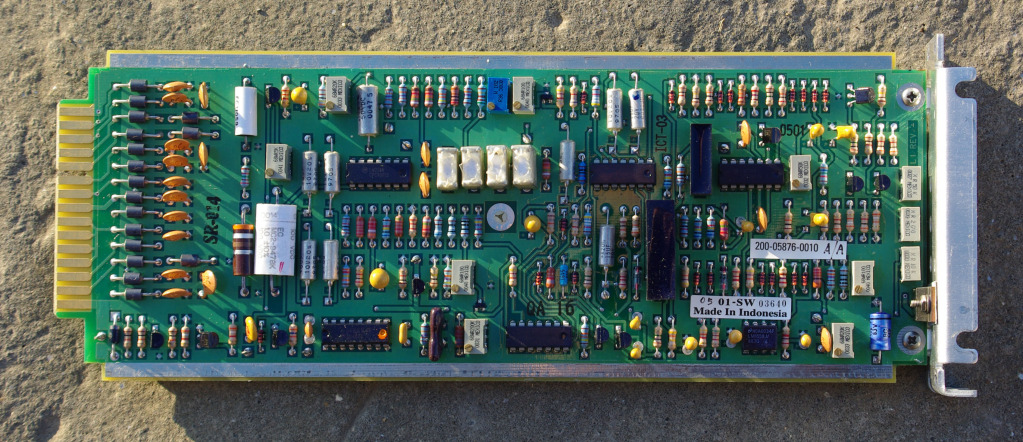
HSI Failure in VOR Mode
This article describes a failure mode of a Bendix/King (Honeywell) KI-525 HSI, when operating as a VOR indicator.
The relevant section of the instrument panel is here

and the video (20MB MPG) is here.
The HSI and the CDI are both tuned to the same test source and should indicate identically at all times.
Explanation
The aircraft has two separate VOR receivers, NAV1 and NAV2. These share a VHF antenna. The HSI is fed from NAV1, and the CDI is fed from NAV2. There is also an RMI whose VOR needle (the thin one) is switchable NAV1/NAV2 but in this example it is working from NAV2 and always indicates identically to the CDI.
NAV1 is a KX155A radio, with a KN72 VOR/LOC converter. NAV2 is a KX165A radio and there is no external converter.
The KN72 converter is a 1970s all-analog design - typical schematic


which processes the demodulated VOR/LOC signal (there is no RF involved at this stage) and generates the deviation of the HSI bar, the TO/FROM flag, and the INVALID flag. The build quality is very good but the high component count makes all kinds of odd failures possible.
In this installation, the KN72 converter failed, in a manner which produced invalid indications on the HSI bar, invalid indications on the TO/FROM flag, but a valid behaviour of the INVALID flag. This is obviously a dangerous failure mode because the main indication of the instrument being untrustworthy - the INVALID flag - is useless. In contrast, a GPS is extremely unlikely to produce an apparently dynamic (moving) instrument indication which is wrong.
The KN72 failure is concealed if the signal is strong. With a signal corresponding to flying within a few miles of a VOR, the KN72 outputs are fine. As the signal is weakened, say at 10D, the instrument indication starts to fall apart, in a gradual manner which would not be obvious to a pilot who is tracking the VOR in the conventionally trained manner and who does not have a separate source of situational awareness (e.g. a moving map GPS).
All 3 instruments were driven from the same ultimate signal source; a VOR/LOC avionics test set. The CDI and the RMI show correct indications at all times, being fed from a different system to the HSI.
The LOC behaviour of the faulty KN72 was not tested because immediately after the video was made the KN72 was replaced. When the inability of NAV1 to track a VOR was originally suspected, airborne tests revealed a blind spot (on both NAV1 and NAV2) at 3 o'clock. This was caused by one of the two VOR/LOC antennae having a broken connection at its base; an extremely subtle fault which could remain undiscovered for years, revealing itself only when flying a VOR approach with a "right base" join, and flying it using the VOR (and not a GPS, in the OBS mode, which is how most people do it). Due to component lead times, it took some time to get the antenna assembly replaced. Because ILS approaches are operationally much more important than VOR approaches (which can be flown using a GPS) extensive ILS tests were done but they failed to show any LOC problems. After the antenna assembly was fixed, no further faults were suspected. A normal avionics test would not have revealed the KN72 failure, and it may have been present for years.
A Warning
The way in which the three components of a VOR (CDI) receiver are generated (the deviation bar, the to/from flags, and the Invalid flag) is a disaster looking for a place to happen. They are generated by separate circuits, which can fail individually.
In contrast, a GPS usually has a single processor which either runs or doesn't. The LCD display will have its own "processor" and this is how the LCD can freeze on a given indication when the main processor crashes, but it will not show anything meaningfully changing. The GPS satellite receiver is usually a separate module, with its own little processor, and if that fails, the main processor will put up a big "no satellite reception etc" message across the screen.
Whereas the VOR (and also LOC/GS ILS receiver system) system uses separate circuits which can fail individually. There lies the danger. The pilot should have a separate source of situational awareness and use it - for example a moving map GPS.
This page last edited 1st July 2014.
Any feedback, reports of dead links, corrections or suggestions much appreciated:
Contact details